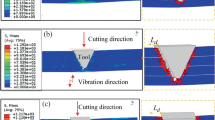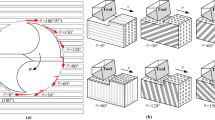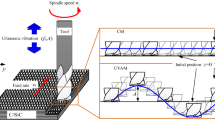Abstract
To address the problems of severe machined surface defects and serious material breakage in unidirectional C/C composites (UD-C/C), this study investigates a UD-C/C composite removal mechanism using ultrasonic-assisted orthogonal cutting technology. A solid cemented carbide cutting edge is used. This study focuses on the chip formation, cutting forces, and morphology of the machined surface in different directions between the tool feed and fiber, including perpendicular to the fiber, along the fiber, along the fiber cross section, and different fiber orientation angles, recorded simultaneously using a high-speed camera. The experimental results indicated that, in the perpendicular direction, damage in the interfacial phase and crack extension in the matrix dominated the chip generation process. The cracks formed during cutting along the fiber direction were relatively short, thus producing continuous segmentation chips. Owing to the accumulation and extrusion of chips, the measured cutting force remained low rather than zero. In the fiber direction, the extension of interfacial cracks in the direction of the fiber and the bending fracture of the fiber dominate in the process of material removal. The matrix was first removed, and the fiber was bent and clung to the rank face, producing a continuous band of chips. The measured cutting force remained stable. In the cross-sectional fiber direction, crack propagation results from interlayer separation, fiber yield, and matrix breakage caused by tool extrusion. The cracks expanded along the interface to the inner part of the material, and discontinuous powders were formed during the cutting process. Moreover, for different fiber orientation angles, the machining quality of the acute cutting zone was significantly better than that of the obtuse cutting zone. Second, the surface topographies of the workpieces were evaluated using a 3D surface-measuring instrument and scanning electron microscopy (SEM). Owing to the occurrence of secondary cutting, the quality of surface topographies cutting perpendicular to the fiber direction improves with increasing cutting depths. The surface topographies cutting along the fiber direction present numerous craters on the surface of the specimen as well as regional surface damage. The surface topographies cutting along the fiber cross-sectional direction show relatively serious machining damage and poor surface machining quality.

























Similar content being viewed by others
Data availability
All data are fully available without restriction.
References
Savage G (1993) The properties of carbon-carbon composites. Carbon-Carbon Composites:277–322. https://doi.org/10.1007/978-94-011-1586-5_8
Christin F (2002) Design, fabrication, and application of thermostructural composites (TSC) like C/C, C/SiC, and SiC/SiC composites. Adv Eng Mater 4(12):903–912. https://doi.org/10.1002/adem.200290001
Singh AP, Sharma M, Singh I (2013) A review of modeling and control during drilling of fiber reinforced plastic composites. Compos Part B-Eng 47:118–125. https://doi.org/10.1016/j.compositesb.2012.10.038
Zhang LC (2009) Cutting composites: a discussion on mechanics modelling. J Mater Process Tech 209(9):4548–4552. https://doi.org/10.1016/j.jmatprotec.2008.10.023
Ferreira J, Coppini N, Neto FL (2001) Characteristics of carbon–carbon composite turning. J Mater Process Technol 109(1):65–71
Shan C, Zhang M, Yang Y, Zhang S,Luo M (2020) A dynamic cutting force model for transverse orthogonal cutting of unidirectional carbon/carbon composites considering fiber distribution. Composite Structures 251. https://doi.org/10.1016/j.compstruct.2020.112668
Gavalda Diaz O, Axinte DA (2017) Towards understanding the cutting and fracture mechanism in ceramic matrix composites. Int J Mach Tools Manuf 118–119:12–25. https://doi.org/10.1016/j.ijmachtools.2017.03.008
Shan C, Dang J, Yan J,Zhang X (2017) Three-dimensional numerical simulation for drilling of 2.5D carbon/carbon composites. Int J Adv Manuf Technol 93(5):2985–2996. https://doi.org/10.1007/s00170-017-0653-y
Shokrieh MM, Lessard LB (2000) Progressive fatigue damage modeling of composite materials, part I: modeling. J Compos Mater 34(13):1056–1080. https://doi.org/10.1177/002199830003401301
Li M, Jiang X, Chen Y, Yang X (2023) Hole surface morphology and tool wear mechanisms during cutting 3D carbon/carbon composites using diamond core drill. Ceram Int 49(4):6378–6388. https://doi.org/10.1016/j.ceramint.2022.10.128
Rusinek R (2010) Cutting process of composite materials: an experimental study. Int J Non-Linear Mech 45(4):458–462. https://doi.org/10.1016/j.ijnonlinmec.2010.01.004
Pecat O, Rentsch R, Brinksmeier E (2012) Influence of milling process parameters on the surface integrity of CFRP. Procedia Cirp 1(9):466–470
Wang XM, Zhang LC (2003) An experimental investigation into the orthogonal cutting of unidirectional fibre reinforced plastics. Int J Mach Tools Manuf 43(10):1015–1022. https://doi.org/10.1016/S0890-6955(03)00090-7
Seeholzer L, Voss R, Grossenbacher F, Kuster F, Wegener K (2018) Fundamental analysis of the cutting edge micro-geometry in orthogonal machining of unidirectional carbon fibre reinforced plastics (CFRP). Proc CIRP 77:379–382. https://doi.org/10.1016/j.procir.2018.09.040
An Q, Ming W, Cai X, Chen M (2015) Study on the cutting mechanics characteristics of high-strength UD-CFRP laminates based on orthogonal cutting method. Compos Struct 131:374–383. https://doi.org/10.1016/j.compstruct.2015.05.035
An Q, Cai C, Cai X,Chen M (2019) Experimental investigation on the cutting mechanism and surface generation in orthogonal cutting of UD-CFRP laminates. Composite Structures 230. https://doi.org/10.1016/j.compstruct.2019.111441
Wang F-j, Yin J-w, Ma J-w, Jia Z-y, Yang F, Niu B (2017) Effects of cutting edge radius and fiber cutting angle on the cutting-induced surface damage in machining of unidirectional CFRP composite laminates. Int J Adv Manuf Technol 91(9):3107–3120. https://doi.org/10.1007/s00170-017-0023-9
Su Y, Jia Z, Niu B,Bi G (2017) Size effect of depth of cut on chip formation mechanism in machining of CFRP. Compos Struct 164(Supplement C):316–327. https://doi.org/10.1016/j.compstruct.2016.11.044
Wang C, Liu G, An Q, Chen M (2017) Occurrence and formation mechanism of surface cavity defects during orthogonal milling of CFRP laminates. Compos B Eng 109:10–22. https://doi.org/10.1016/j.compositesb.2016.10.015
Hintze W, Hartmann D, Schütte C (2011) Occurrence and propagation of delamination during the machining of carbon fibre reinforced plastics (CFRPs) – an experimental study. Compos Sci Technol 71(15):1719–1726. https://doi.org/10.1016/j.compscitech.2011.08.002
Hintze W, Brügmann F (2018) Influence of spatial tool inclination on delamination when milling CFRP. J Mater Process Technol 252:830–837. https://doi.org/10.1016/j.jmatprotec.2017.10.041
Singh RP, Singhal S (2016) Rotary ultrasonic machining: a review. Mater Manuf Process 31(14):1795–1824. https://doi.org/10.1080/10426914.2016.1140188
Wang JJ, Zhang JF, Feng PF, Guo P (2018) Damage formation and suppression in rotary ultrasonic machining of hard and brittle materials: a critical review. Ceram Int 44(2):1227–1239. https://doi.org/10.1016/j.ceramint.2017.10.050
Gao G, Xia Z, Yuan Z, Xiang D, Zhao B (2021) Influence of longitudinal-torsional ultrasonic-assisted vibration on micro-hole drilling Ti-6Al-4V. Chinese J Aeronaut 34(9):247–260. https://doi.org/10.1016/j.cja.2020.06.012
Geng D, Liu Y, Shao Z, Zhang M, Jiang X, Zhang D (2020) Delamination formation and suppression during rotary ultrasonic elliptical machining of CFRP. Compos Part B-Eng 183:107698. https://doi.org/10.1016/j.compositesb.2019.107698
Cao Y, Yin J, Ding W, Xu J (2021) Alumina abrasive wheel wear in ultrasonic vibration-assisted creep-feed grinding of Inconel 718 nickel-based superalloy. J Mater Process Technol 297:117241. https://doi.org/10.1016/j.jmatprotec.2021.117241
Miao Q, Ding W, Xu J, Cao L, Wang H, Yin Z, Dai C, Kuang W (2021) Creep feed grinding induced gradient microstructures in the superficial layer of turbine blade root of single crystal nickel-based superalloy. Int J Extreme Manuf 3(4):045102. https://doi.org/10.1088/2631-7990/ac1e05
Cao Y, Ding W, Zhao B, Wen X, Li S, Wang J (2022) Effect of intermittent cutting behavior on the ultrasonic vibration-assisted grinding performance of Inconel718 nickel-based superalloy. Precis Eng 78:248–260. https://doi.org/10.1016/j.precisioneng.2022.08.006
Cao Y, Zhu Y, Ding W, Qiu Y, Wang L, Xu J (2022) Vibration coupling effects and machining behavior of ultrasonic vibration plate device for creep-feed grinding of Inconel 718 nickel-based superalloy. Chin J Aeronaut 35(2):332–345. https://doi.org/10.1016/j.cja.2020.12.039
Cao Y, Zhu Y, Nan Li H, Wang C, Su H, Yin Z, Ding W (2020) Development and performance of a novel ultrasonic vibration plate sonotrode for grinding. J Manuf Process 57:174–186. https://doi.org/10.1016/j.jmapro.2020.06.030
Zhang M, Pang Z, Jia Y, Shan C (2022) Understanding the machining characteristic of plain weave ceramic matrix composite in ultrasonic-assisted grinding. Ceram Int 48(4):5557–5573. https://doi.org/10.1016/j.ceramint.2021.11.100
Lu D, Wang Q, Wu Y, Cao J, Guo H (2014) Fundamental turning characteristics of Inconel 718 by applying ultrasonic elliptical vibration on the base plane. Mater Manuf Process 30(8):1010–1017. https://doi.org/10.1080/10426914.2014.973588
Geng D, Lu Z, Yao G, Liu J, Li Z, Zhang D (2017) Cutting temperature and resulting influence on machining performance in rotary ultrasonic elliptical machining of thick CFRP. Int J Mach Tool Manu 123:160–170. https://doi.org/10.1016/j.ijmachtools.2017.08.008
Koplev A, Lystrup A, Vorm T (1983) The cutting process, chips, and cutting forces in machining Cfrp. Composites 14(4):371–376. https://doi.org/10.1016/0010-4361(83)90157-X
Zhang M, Shan C, Xia Z, Luo M,Zhang D (2023) Scratch - induced surface formation mechanism in C/SiC composites. Int J Mech Sci 108885. https://doi.org/10.1016/j.ijmecsci.2023.108885
Yu W, Chen J, An Q, Ming W, Chen M (2023) Investigations on the effect of ultrasonic vibration on fibre fracture and removal mechanism in cutting of fibre reinforced silicon carbide ceramic matrix composites. J Manuf Process 94:359–373. https://doi.org/10.1016/j.jmapro.2023.03.049
Xue F, Zheng K, Liao W, Shu J,Dong S (2021) Investigation on fiber fracture mechanism of c/sic composites by rotary ultrasonic milling. Int J Mach Tool Manu 191. https://doi.org/10.1016/j.ijmecsci.2020.106054
Xie ZW, Liu ZQ, Wang B, Xin MZ, Song QH, Jiang LP (2021) Longitudinal amplitude effect on material removal mechanism of ultrasonic vibration-assisted milling 2.5D C/SiC composites. Ceram Int 47(22):32144–32152. https://doi.org/10.1016/j.ceramint.2021.08.106
Acknowledgements
The authors deeply acknowledge the Key Laboratory of High Performance Manufacturing for Aero Engine (Northwestern Polytechnical University) and Engineering Research Center of Advanced Manufacturing Technology for Aero Engine (Northwestern Polytechnical University) for providing us with the ability to conduct this research.
Funding
This work was co-supported by the National Natural Science Foundation of China (Nos. 51875473 and 91960203), the Science Center for Gas Turbine Project (P2021-A-IV-003–001), and the Fundamental Research Funds for the Central Universities (D5000230048).
Author information
Authors and Affiliations
Contributions
Fangchao Jia: methodology, validation, and writing—original draft; Chenwei Shan: conceptualization, methodology, supervision, funding acquisition, and writing—review and editing; Ziwen Xia: visualization; Zixuan Pang: investigation; and Menghua Zhang: supervision and writing—review and editing.
Corresponding author
Ethics declarations
Ethics approval
This paper does not include any research conducted by any author with humans or animals as participants.
Consent to participate
The datasets analyzed during the current study are available from the corresponding author on reasonable request.
Consent for publication
All authors have agreed on the publication.
Competing interests
The authors declare no competing interests.
Additional information
Publisher's Note
Springer Nature remains neutral with regard to jurisdictional claims in published maps and institutional affiliations.
Rights and permissions
Springer Nature or its licensor (e.g. a society or other partner) holds exclusive rights to this article under a publishing agreement with the author(s) or other rightsholder(s); author self-archiving of the accepted manuscript version of this article is solely governed by the terms of such publishing agreement and applicable law.
About this article
Cite this article
Jia, F., Shan, C., Xia, Z. et al. Material removal mechanism of UD-C/C composites in ultrasonic-assisted vibration orthogonal cutting. Int J Adv Manuf Technol 130, 851–869 (2024). https://doi.org/10.1007/s00170-023-12776-1
Received:
Accepted:
Published:
Issue Date:
DOI: https://doi.org/10.1007/s00170-023-12776-1




